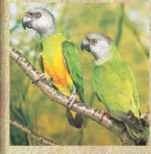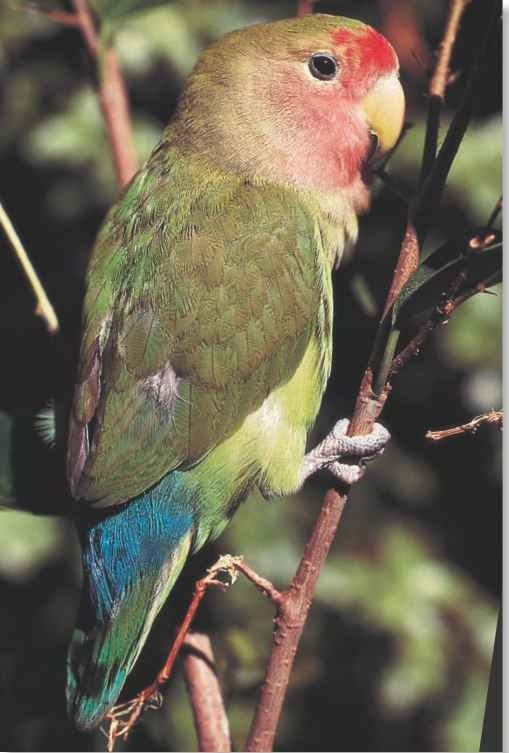ORDER
Psittaciform.es
FAMILY
Psittacidae
GENUS & SPECIES
key features
• Family of tiny, highly acrobatic parrots
• Each pair spends long periods nestled side by side, nibbling each other’s feathers to strengthen their pair bond
• Some species carry nest material buried among their feathers
• Males and females of different species can mate and produce hybrid offspring
where in the world?
Found in tropical and subtropical forests in Africa, from Guinea |j east to Ethiopia, Kenya and Tanzania, and in parts of Mozambique, Zambia, Malawi, Angola and Namibia; one species confined to Madagascar

Lifecycle
Lovebirds are named after their “affectionate” habit of billing and preening each other as if in a loving embrace. This behavior reinforces the bonds between the male and female.
HABITAT
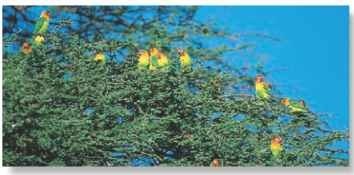
A Treetop jewels
Flock of Fischer’s lovebirds in savannah woodland.
Lovebirds are found in tropical and subtropical forests and more open types of woodland. Each species favors slightly different habitats, but more than one species can be found together.
The red-faced lovebird, which has the widest distribution of any lovebird, lives in primary rainforest broken by clearings, secondary forest and wooded plains up to an altitude of 4,950′. Some lovebird species prefer lowland evergreen forests, while the black-winged lovebird inhabits juniper forests in the highlands of Ethiopia.
Even arid or rocky country is a suitable habitat to such species as the peach-faced lovebird, which is found in dry steppes in southwestern Africa; a few others adapt readily to fields. Nyasa and black-cheeked lovebirds are specialized; both are restricted to open stands of the low-growing mopane tree.

A Cliff-hanger Peach-faced lovebirds nest in cliffs instead of trees.
# Most small birds mate for a few seconds at a time, but lovebirds stay coupled for up to six minutes.
Up to 25 Nyasa lovebirds may roost together in a single tree hole. They enter one at a time and tail-first.
FOOD & FEEDING
Lovebirds do not travel far, so their home ranges must provide a reliable, year-round supply of food. Most lovebird species live on flowers, seeds, fruit and leaf buds — depending on seasonal availability — which the birds supplement with insects and grubs. Some species, such as the black-collared lovebird, feed mainly on figs in treetops, but others, including the red-faced and gray-headed lovebirds, gather grass seeds at ground level.
The lovebirds’ superb bill-foot coordination enables them to use its four-clawed feet as a clamp to hold food while the bird breaks up the morsel with its bill. The lovebird may also use a foot to transfer food to its bill. Lovebirds also have a strong tongue to remove seeds from husks.
Pretty in pink Plants in full flower attract hungry lovebirds.
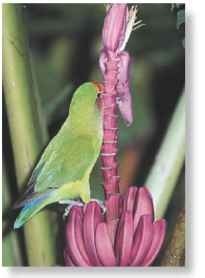
CONSERVATION
Lovebirds are very popular pets and trapping to supply the cage-bird trade has led to serious declines in the populations of most species. Today, legal protection has helped increase lovebird numbers again, but recovery is a slow process. The black-cheeked lovebird remains endangered and is found only in a 2,400 sq. mile stretch of wooded river valley.
BREEDING
Most lovebirds breed in colonies, but some nest in isolated pairs. Lovebirds make their nests in cliff faces, termite mounds, holes excavated by woodpeckers and nests of swifts, weavers, sparrows and other birds.
The female builds and guards the nest, incubates the eggs for three weeks, then broods the chicks.The male doesn’t help her until the chicks are olde^when he starts to bring food to them.The young lovebirds are born blind and helpless, and fledge after six weeks in the nest. A pair of lovebirds usually manages to raise three or four offspring a year
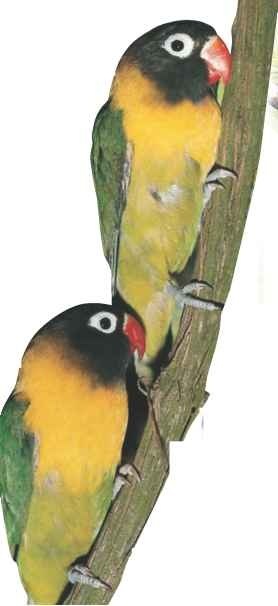
The look of love
Pair of Fischer’s lovebirds (right) mating. Far right: the peach-faced lovebird.
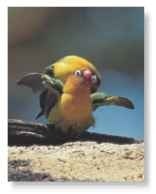
LABOR OF LOVE
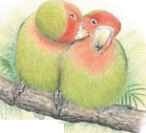
Caress…
To reaffirm the bond between them, a male peach-faced lovebird treats his mate to gentle preening at the pair’s chosen nest site.
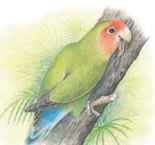
Collect…
Encouraged by his attention, the female flies to a nearby tree and tears off thin strips of bark tto use as nest material.
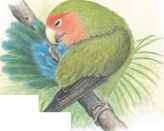
Load…
Using her bill, she tucks the bark into her soft rump feathers and stows away more strips until her plumage can carry no more.
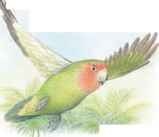
Carry
She drops some bark pieces as she flies back to her mate, but holds onto enough to start building her nest.
BEHAVIOR
Like many members of the parrot family, lovebirds are highly sociable. / From sunset until daybreak, the) roost together During the day, they’re usually seen in flocks of 20 or so, but gatherings of up to 300 occur at a particularly rich food source, such as a fig-laden tree or a field of ripe grain. When they’re not searching for \ food, lovebirds devote much of their time to their ^ bill and feathers. They repeatedly nibble at hard objects, such as branches, to keep their continuously growing bill at a perfect length.The lovebird uses its feet to take oil from a gland near the base of its tail, then applies it through its plumage. Lovebirds bathe regularly; the gray-headed lovebird cleans its plumage by hanging upside down from a branch in the rain.
Lovebirds communicate with high-pitched calls and by adopting specific poses, such as lowering their head and opening their wings to show hidden colors.
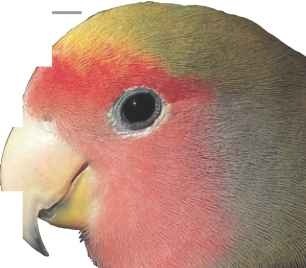
PROFILE
Lovebirds
Dexterous feet and miniature, lightweight bodies make all lovebirds more agile than many of their larger relatives in the parrot family.
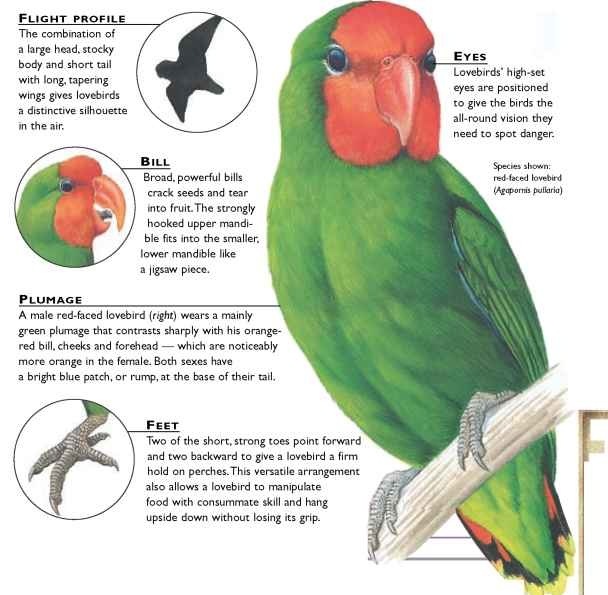
CREATURE COMPARISONS
Identifying lovebirds in the wild can be a challenge, especially where a number of species occur These six examples illustrate differences among nine species. Masked, black-cheeked, Fischer’s and Nyasa lovebirds have broad, naked eye rings; both sexes have similar plumage. Red-faced, Abyssinian and gray-headed (or Madagascar) lovebirds have less prominent feathered eye rings; the sexes have dissimilar plumage. Peach- faced and black-collared lovebirds
Gray-headed Black- Masked have characteristics from both groups.
Fischer’s Peach- Abyssinian (male) cheeked faced (male)

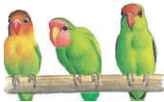
| vital statistics | |
| Weight | 1-2 oz. |
| Length | 5-6.5″ |
| Wingspan | 9-12″ |
| Sexual Maturity Breeding Season |
1 year |
| Varies between species and regions | |
| Number of Eggs | 3-8; usually 3 or 4 |
| Incubation Period | 22-23 days |
| Fledging Period | 38-50 days; 43- 44 days in most species |
| : Breeding Interval | 1 year |
| Typical Diet | Seeds, flowers, fruit, leaf buds; some insects |
| Lifespan | About 12 years in captivity |
Related species
• Lovebirds, cockatoos, parrots, lories, parakeets, parrotlets and macaws all belong to the Psittacidae ifamily, which has about 350 species, including the Senegal parrot, Poicephalus senegalus (below).
